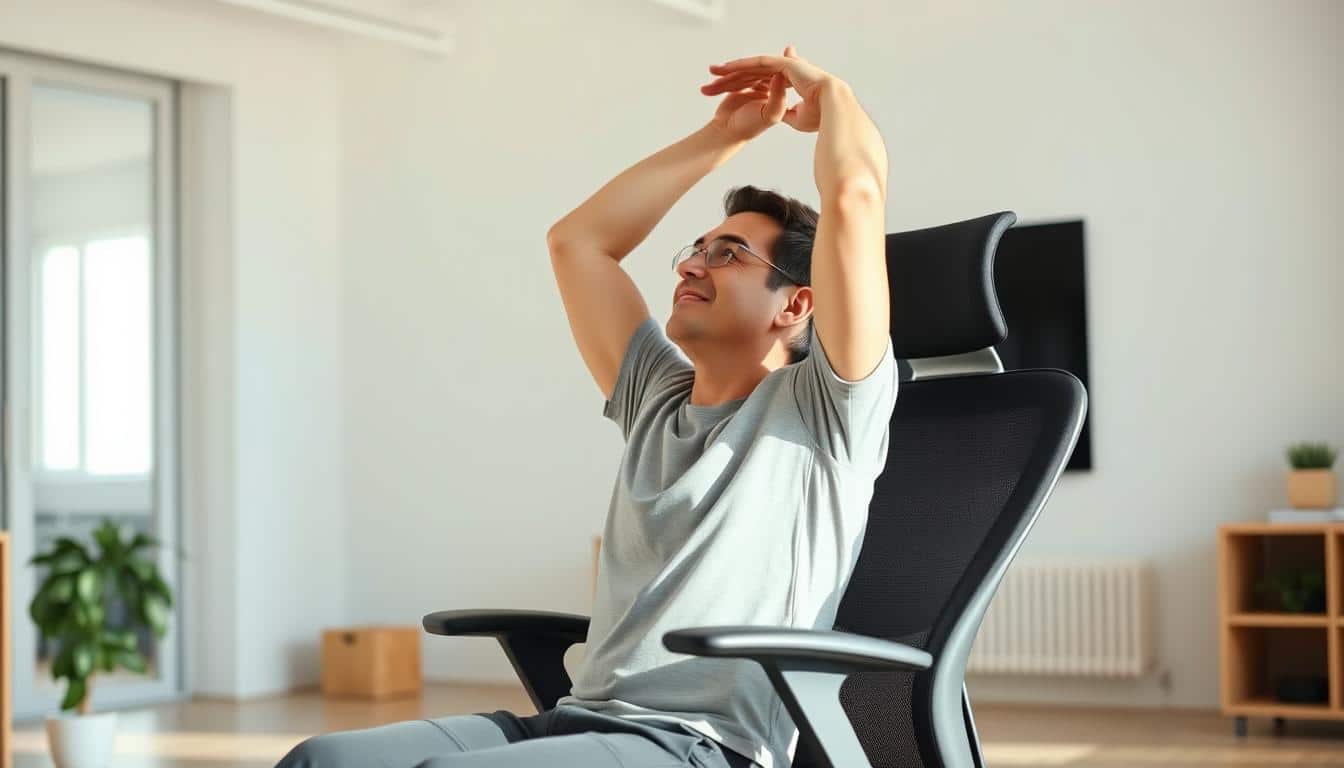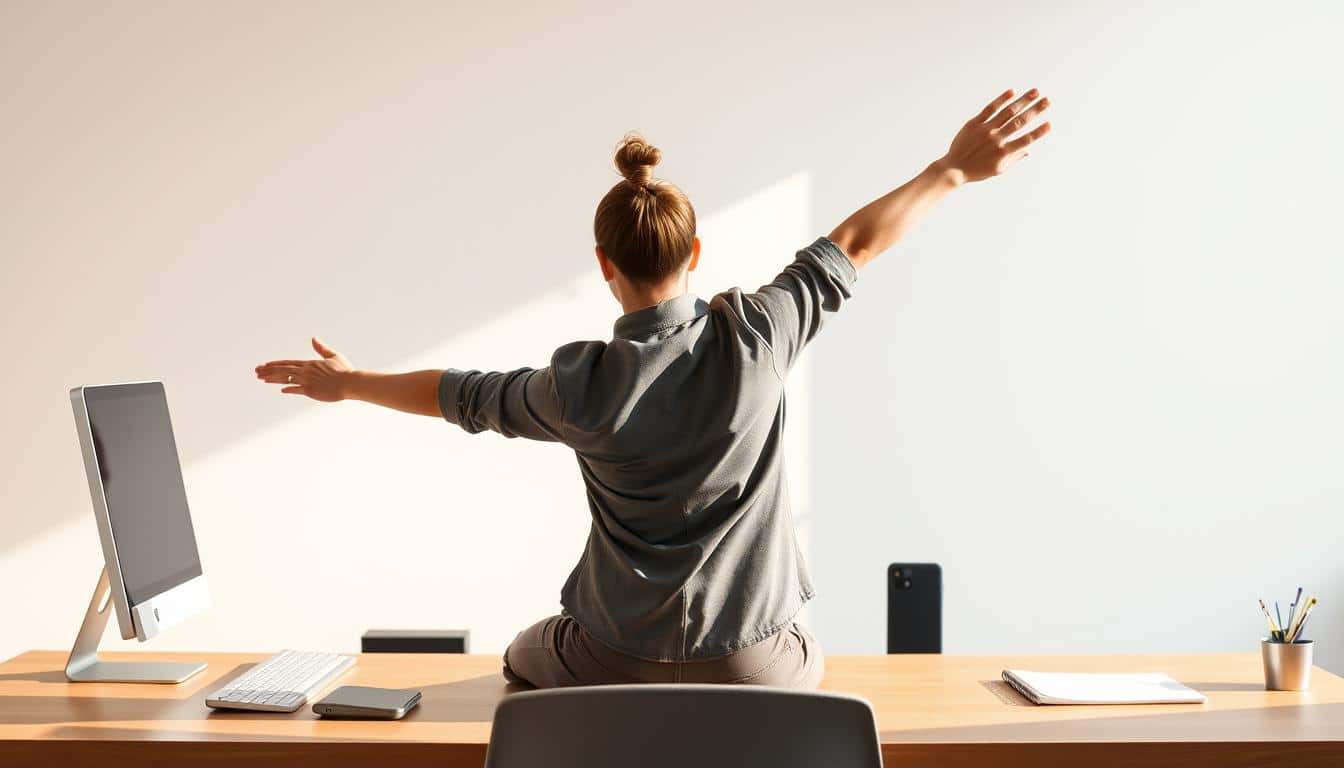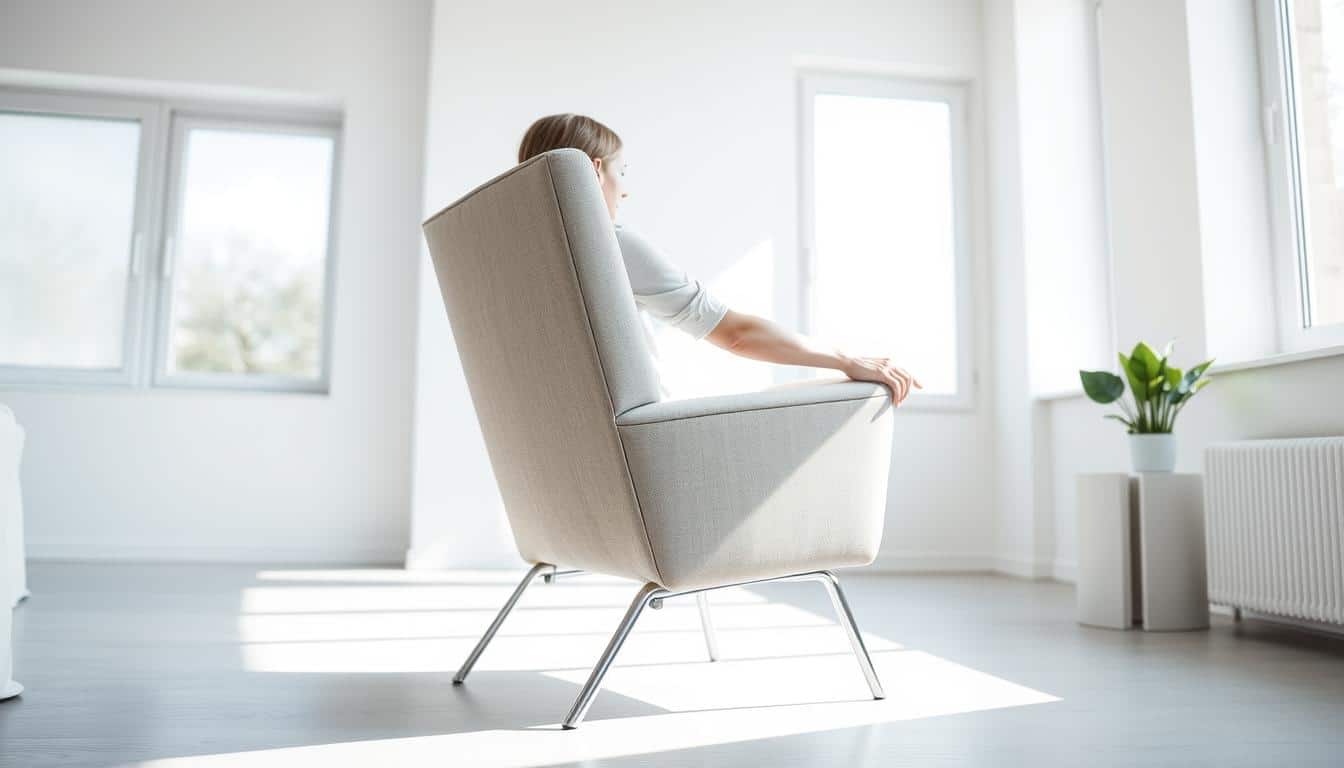Anúncios
This short guide focuses on practical chair stretches for neck and back pain relief you can do at your desk or anywhere you sit. It explains simple desk stretches and seated back pain exercises that require no equipment, with clear safety notes and easy modifications.
Anúncios
Whether you work at Google, drive for Uber, care for family members, or log long hours at home, these moves aim to improve workplace mobility and offer office neck pain relief in minutes. Expect friendly, evidence-informed tips, brief routines, and guidance on consistency so you can fit movement into a busy day.
The article centers on one promise: discover simple, easy-to-follow tips to feel better from your chair. Along the way you’ll find how to set up your chair properly, recognize warning signs, and know when to seek help from a physical therapist or clinician.
Key Takeaways
- Chair stretches for neck and back pain relief are quick and need no special gear.
- Desk stretches can reduce stiffness and boost workplace mobility during the day.
- Seated back pain exercises are adaptable for different fitness and mobility levels.
- Short, regular movement breaks help prevent office neck pain relief from becoming a long-term issue.
- Learn safe modifications and when to consult a healthcare professional.
Why Chair Stretches Help Neck and Back Pain
Sitting through long workdays changes how our bodies load the spine. Small, regular movements and brief stretches help interrupt harmful patterns and bring blood flow back to tight muscles. This section explains the mechanics of poor posture, the physiological payoffs of tiny breaks, and the research that supports desk-friendly mobility work.
How prolonged sitting affects posture and spinal health
Sustained hip flexion from sitting pulls the pelvis into a posterior tilt. That shortens the hip flexors and weakens the gluteal muscles, which raises strain on the lumbar spine. Forward head posture is common with screen work; every inch the head moves forward increases load on the cervical spine. Reduced thoracic mobility forces the neck and lower back to compensate, which magnifies sedentary posture effects over weeks and months.
The American Physical Therapy Association and other professional bodies warn that long periods of inactivity increase risk for pain and dysfunction. These groups recommend regular position changes to limit the mechanical stress that drives chronic symptoms.
Benefits of micro-movements and gentle stretching throughout the day
Breaking up static positions with short, frequent breaks improves circulation and reduces stiffness. Micro-movements benefits include better synovial fluid distribution in joints, decreased nociceptive signaling, and quicker muscle recovery during the workday. Even one to five minutes every 30 to 60 minutes can reset posture and lower perceived fatigue.
Regular gentle stretching helps muscles maintain length and supports balanced activation. Workers who use micro-breaks report less stiffness and more comfort when performing repetitive tasks or long computer sessions.
Research evidence supporting desk-based stretching and mobility work
Clinical trials and systematic reviews show that workplace stretching programs lower musculoskeletal discomfort in office staff. Short, consistent routines reduce neck and shoulder pain and can improve perceived productivity. Research emphasizes that desk stretching is not a cure for structural spine disease, but it is an evidence-backed strategy to reduce symptoms and improve function.
| Focus | Intervention | Typical Outcome |
|---|---|---|
| Neck and shoulder pain | Five-minute stretch breaks, 3 times daily | Reduced pain scores, improved range of motion |
| Low-back discomfort | Frequent micro-movements + lumbar cues | Lower perceived stiffness, better sitting tolerance |
| Overall office wellness | Workplace exercise programs with short sessions | Fewer sick days, higher self-reported productivity |
Chair Stretches for Neck and Back Pain Relief
Start with small, easy movements that you can do at your desk. These chair stretches target tight muscles and help restore normal movement patterns. Breathe slowly and stop if you feel sharp pain or radiating symptoms.
Gentle neck tilts and rotations to reduce stiffness
Sit tall with feet flat and shoulders relaxed. Tilt your right ear toward your right shoulder and hold 15–30 seconds. Repeat on the left side. Perform gentle chin tucks to lengthen the back of the neck, then do slow controlled rotations by looking over each shoulder 5–10 times.
Avoid quick, jerky motions. If numbness, tingling, or sharp pain appears, pause and consult a clinician. These seated neck stretches reduce posterior neck tightness, improve cervical mobility, and ease forward-head stress.
Seated cat-cow to mobilize the thoracic spine
Sit with hands on your knees. Inhale and arch your mid-back while lifting the chest; this is the cow. Exhale and round the thoracic spine, drawing the chin toward the chest; this is the cat. Link breath to movement and perform 6–10 slow cycles.
Focus on creating motion through the thoracic area. The seated cat cow helps restore extension and flexion of the mid-spine, which unloads strain from the neck and lower back.
Seated spinal twist to relieve lower back tension
Keep both feet flat. Place your right hand on the outside of your left knee and rotate gently from the base of the spine. Hold 15–30 seconds, then switch sides. Repeat 2–3 times per side.
You can use the chair back for support or to limit the range if you need a gentler option. Avoid twisting after recent spinal surgery or when discs feel unstable. The seated spinal twist eases lumbar tightness and improves rotational mobility.
Shoulder rolls and scapular squeezes for upper back comfort
Begin with 10 slow shoulder rolls forward, then 10 backward. Follow with scapular squeezes: pinch your shoulder blades together, hold 3–5 seconds, and repeat 8–12 times. Keep the neck relaxed while you do these.
These upper back stretches restore scapular motion, reduce trapezius overactivity, and promote better posture. Pair them with the other moves for a balanced desk routine.
Quick Chair Routine You Can Do at Your Desk
Short, simple movement breaks stop stiffness and boost focus. Use the quick sequences below between tasks to get immediate benefits without leaving your chair. The steps are safe, gentle, and designed for busy workdays.
60-second sequence for immediate relief
Try this 60-second desk stretches sequence when you need quick neck and back relief before a call. Start with 10 seconds of chin tucks to reset head alignment. Follow with 10 seconds of slow neck tilts to each side to ease tight muscles. Do 10 shoulder rolls forward and 10 backward to free the upper back. Finish with 10 seconds of seated cat-cow, moving gently between arch and round to wake the thoracic spine. This short routine increases blood flow and reduces acute stiffness between meetings.
5-minute routine for a mid-morning or mid-afternoon reset
When you have five minutes, use this 5-minute chair routine for a fuller reset. Begin with 30 seconds of diaphragmatic breathing to calm the nervous system and connect breath to movement. Spend one minute on neck mobility: slow rotations and side-to-side glides with mindful breathing. Use one minute for seated cat-cow, holding each phase for three to five breaths to mobilize the mid-back. Take one minute for seated spinal twists and gentle side bends to open the lower ribs and relieve lumbar tension. End with 30 seconds of scapular squeezes and controlled shoulder rolls to restore posture. Move at a steady tempo, inhale on lengthening, exhale on release. This longer break eases stiffness and helps refocus attention.
How to fit the routine into breaks without disrupting work
Schedule an office stretch break every 45 to 60 minutes to prevent fatigue. Pair stretches with natural pauses like phone calls, coffee runs, or waiting for files to load. Use standing meetings or short walks when possible to vary posture. While on long virtual meetings, perform discreet stretches when you are not speaking to maintain comfort. Set smartphone timers or use wearable reminders so movement becomes automatic. If your company has a wellness program, suggest short group stretch prompts to normalize micro-breaks.
Below is a compact plan you can copy into a calendar or handout. It shows timing, purpose, and simple cues to make the routines easy to follow.
| Routine | Duration | Key Moves | Main Benefit |
|---|---|---|---|
| Instant Reset | ~60 seconds | Chin tucks 10s, neck tilts 10s each side, 10 shoulder rolls each direction, seated cat-cow 10s | Quick neck and back relief; restores circulation |
| Focused Break | 5 minutes | 30s diaphragmatic breathing, 1m neck mobility, 1m seated cat-cow, 1m twists/side bends, 30s scapular work | Reduces stiffness and improves concentration |
| Integration Tips | Ongoing | Timer reminders, pair with natural breaks, discreet moves during calls | Makes an office stretch break part of your day |
Proper Chair Setup to Maximize Stretch Benefits
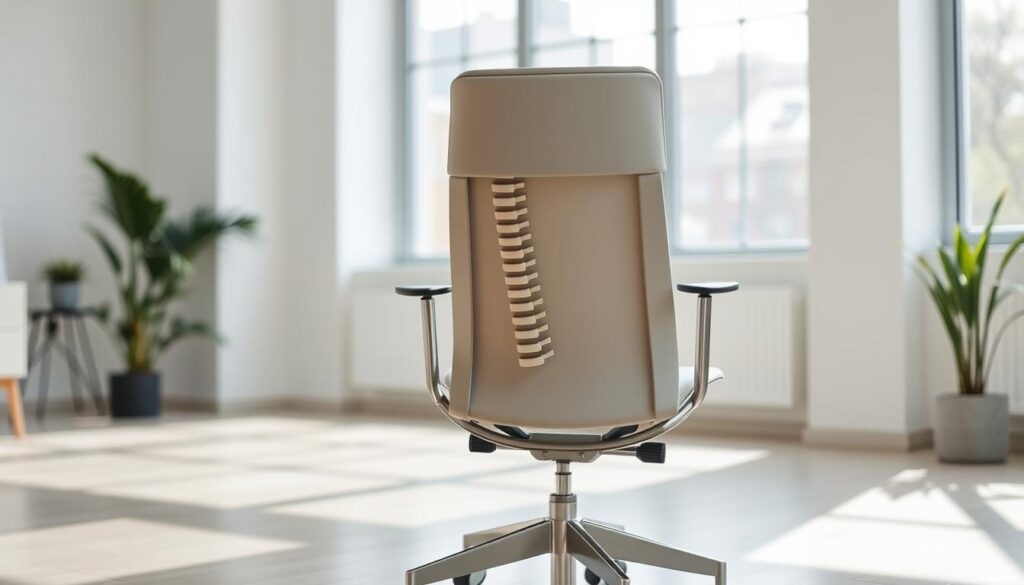
Small adjustments to your chair and workstation make stretches more effective. A thoughtful ergonomic chair setup creates a base that supports movement, reduces strain, and helps you hold neutral spine seating between practice sessions.
Seat height and depth
Set seat height so your feet rest flat and knees sit at about 90 degrees or slightly lower than the hips. Thighs should be roughly parallel to the floor. This position eases pelvic tilt and lowers lumbar strain.
Check seat depth by sliding forward until you feel the backrest support. Leave 1–2 inches between the seat edge and the back of the knee to avoid pressure on posterior thighs. Proper seat depth keeps you stable when you perform seated cat-cow and twists.
Backrest support and lumbar positioning
Use built-in lumbar support or a small lumbar roll placed at the natural inward curve of the lower back. Aim for support at the L3–L5 region so the spine maintains its neutral curve.
Set the backrest recline to about 100–110 degrees when resting. This angle lowers disc pressure and lets the lower back relax. Consistent lumbar support helps stretches hold their benefits between sessions.
Armrests, monitor height, and keyboard placement
Adjust armrests so shoulders stay relaxed and elbows rest near 90 degrees while typing or using the mouse. Good arm support reduces neck and upper back tension during long work periods.
Place the monitor at eye level to prevent forward head posture. Keep keyboard placement close enough to avoid reaching; wrists should remain neutral and forearms near parallel to the floor. These details—monitor height and keyboard placement—cut down compensatory muscle use and let chair stretches target the right muscles.
| Adjustment | Target Position | Benefit for Stretching |
|---|---|---|
| Seat height | Feet flat, knees ~90° | Supports pelvic alignment for neutral spine seating |
| Seat depth | 1–2 in. gap behind knees | Prevents thigh pressure and allows full lumbar contact |
| Lumbar support | Pad at natural lower-back curve | Mantains lumbar support between stretches |
| Backrest recline | 100–110° | Reduces disc pressure and aids relaxation |
| Armrests | Shoulders relaxed, elbows ~90° | Limits shoulder tension so upper-back stretches work better |
| Monitor height | Top of screen at eye level | Prevents forward head posture and neck strain |
| Keyboard placement | Close, wrists neutral | Reduces reaching and allows stable posture for stretches |
Modifications for Limited Mobility or Pain Conditions
If you live with chronic neck or back pain, gentle adjustments make chair work safer and more effective. Start by dialing back range of motion, moving slowly, and using the chair back for support. Short holds of 10–15 seconds and fewer repetitions help prevent flare-ups while you build tolerance.
Adapting stretches for chronic neck or back conditions
When symptoms persist, favor unilateral variations if one side hurts. For example, perform a single-arm shoulder roll rather than both at once. Use the backrest to support the lumbar curve during seated cat-cow or small thoracic rotations. Slow cadence and gentle breathing lower the risk of aggravation.
Consult a clinician before progressing. A physical therapist can tailor movements, set safe limits, and suggest progression from short holds to longer mobility work.
Safer alternatives for those with herniated discs or severe stenosis
Avoid deep twisting and loaded forward flexion if discogenic pain is acute. Try gentle extension-based mobility, such as standing back bends performed within a pain-free range. Neural glides may ease radicular symptoms when guided by a clinician.
Isometric scapular and neck stabilization exercises can maintain strength without stressing the spine. Many people need a rehab plan from a physical therapist to safely return to longer routines.
When to use heat, cold, or supportive braces in conjunction
Use ice for acute inflammation, typically in the first 48–72 hours after a flare. Apply heat for chronic stiffness or just before stretching to increase tissue extensibility. These simple steps improve comfort during chair stretches modifications and seated stretches limited mobility sessions.
Supportive braces, such as temporary lumbar belts or soft cervical collars, offer short-term relief when used under clinician guidance. Avoid long-term dependency; braces should assist rehab, not replace it.
| Issue | Safe Modifications | When to Use Heat and Cold |
|---|---|---|
| Chronic neck pain | Reduce range, slow movements, unilateral neck stretches, short holds (10–15s) | Heat before stretching; ice after any acute flare for 48–72 hours |
| Herniated disc with leg pain | Skip deep twists and loaded flexion; favor gentle extensions, neural glides under clinician care | Ice for new inflammation; heat for persistent stiffness before mobility work |
| Severe spinal stenosis | Limit range, focus on upright posture, isometric scapular and neck holds, clinician-led plan | Heat to ease chronic tightness; avoid heat during active inflammation |
| Limited overall mobility | Seated stretches limited mobility: use backrest, props, and progressive steps; fewer reps | Use heat to prepare tissues; ice only for recent swelling |
| Acute flare-ups | Stop provocative moves, reduce intensity, rely on clinician advice before resuming | Ice in the first 48–72 hours, then switch to heat for persistent stiffness |
Breathing and Mindfulness Techniques to Enhance Stretching
Small shifts in breath and attention change how your body responds to chair stretches. Use simple practices to calm the nervous system, notice early tension, and widen range of motion. Below are three brief, practical techniques you can try at your desk.
Diaphragmatic breathing to reduce muscle tension
Sit tall with feet flat and shoulders relaxed. Place one hand on the ribcage and the other on the belly. Inhale slowly for 4–5 seconds, letting the belly rise. Exhale fully for 5–6 seconds, letting the belly fall. Repeat for 1–3 minutes.
Diaphragmatic breathing desk practice downregulates sympathetic tone, lowers trapezius tension, and improves oxygen delivery to working muscles. Use this pattern before a set of neck or back stretches to reduce guarding and make movement smoother.
Using mindful pauses to notice posture and pain signals
Every 30–60 minutes, take a 20–30 second pause for a quick body scan. Check head position, shoulder height, pelvic tilt, and breath quality. Name any tight areas in your mind and note small changes.
Mindful posture breaks build awareness that helps you correct slouching before it becomes a painful pattern. Short, regular checks let you intervene early with a breath and stretch or a tiny adjustment to your chair setup.
Simple progressive relaxation to combine with stretches
Begin with seated attention on the feet, then move upward. Tense the shoulders for 3–4 seconds, release while exhaling. Move to the neck, then the upper back, then the lower back, tensing and releasing each area. A 3–5 minute sequence is enough before you start stretching.
Progressive relaxation at work reduces muscle guarding and creates space for safer, fuller movements. Pair it with a breath and stretch routine: inhale to prepare, exhale as you release tension and move into a gentle stretch.
Ergonomic Accessories That Complement Chair Stretches
Small tools can keep the benefits of your chair stretches working all day. Choose items that support posture, reduce pressure, and remind you to move. These additions pair well with the mobility work you already do.
Lumbar supports and rolled towels for sustained posture
Adding lumbar support cushions from trusted brands such as Everlasting Comfort or Tempur-Pedic helps preserve the curve of your lower spine between stretch sessions. A simple rolled towel placed at the small of the back offers a low-cost option that reduces low-back strain and helps stretches last longer.
Footrests, seat cushions, and standing desk converters
Shorter people benefit from footrest benefits that keep hips at a healthy angle and reduce pressure on the lower back. Memory foam or gel seat cushions ease sit-bone discomfort and make seated stretches feel safer. Adjustable standing desk converters, such as Varidesk models, let you shift to standing to change loading patterns and support regular movement.
Wearable reminders and apps to prompt movement breaks
Movement reminder apps and wearables improve consistency with micro-breaks. Try desktop timers like Stretchly, breathing tools like Breathe2Relax, or device reminders built into Apple and Android systems. Wearables such as Apple Watch or Fitbit provide gentle nudges to stand and move, making it easier to follow a stretching routine all day.
Preventing Recurrence: Daily Habits Beyond Chair Stretches
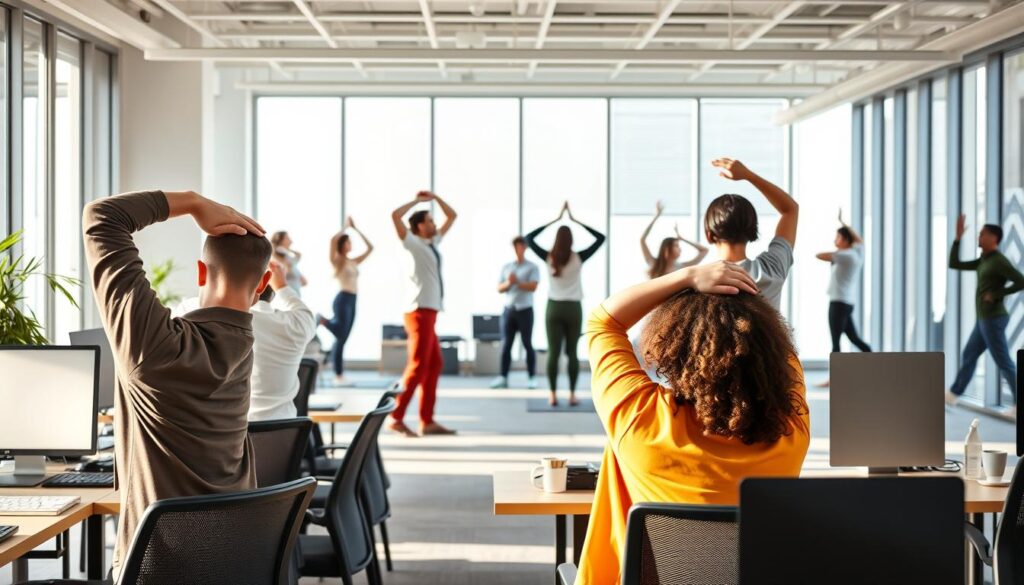
Small habits outside of seated stretches make a big difference for people who want to prevent back pain recurrence. Mix movement, strength work, and recovery habits into your routine so the spine gets stable support and regular circulation.
Regular walking and movement goals for the workday
Aim to stand or walk briefly every 30–60 minutes. Short walks boost circulation and provide dynamic loading that helps intervertebral discs. Set realistic step goals based on your baseline, such as 5,000–10,000 daily steps, and try walking meetings when possible.
Strength and mobility exercises to support the spine
Add targeted moves to complement chair stretches. Include glute bridges, bodyweight hip-hinge patterns like a Romanian deadlift, planks for core endurance, thoracic extension drills with a foam roller, and band pull-aparts for scapular stability.
Schedule 2–3 sessions per week for maintenance. Progress under guidance from a physical therapist or certified trainer when pain or limitations exist.
Sleep, hydration, and nutrition factors affecting recovery
Quality sleep of 7–9 hours and steady hydration support tissue repair and reduce pain sensitivity. Favor anti-inflammatory foods rich in omega-3s and antioxidants to aid nutrition for recovery. Watch caffeine and alcohol intake since both can reduce sleep quality and increase muscle tension.
Balance these daily habits with your chair routine. Clear workplace movement goals and consistent spinal strengthening exercises paired with good sleep and nutrition for recovery give the best chance to prevent back pain recurrence.
Safety Tips and When to See a Professional
Chair stretches help many people, but certain signs mean you should pause and seek expert help. This short guide shows red flags, how to read your body’s response, and which professionals can help with tailored care. Keep reading so you know when to act and who to call.
Warning signs that warrant medical evaluation
Seek prompt attention if you notice new or worsening numbness or tingling down an arm or leg. Progressive weakness, sudden bowel or bladder changes, and severe night pain that won’t let you sleep are urgent issues. A fever with back pain or recent trauma to the spine also needs immediate assessment. These are common red flags that indicate a serious problem rather than normal muscle strain.
How to tell if a stretch is helping or aggravating symptoms
Beneficial responses include less stiffness, lower pain intensity, improved range of motion, and easier daily tasks. Stop the stretch if you feel sharp, shooting, or radiating pain. Increasing numbness or persistent worsening after a session are clear stretch safety signs that you should not ignore. Try a gentler modification and rest; if symptoms stay or worsen, contact your clinician.
Working with physical therapists, chiropractors, or ergonomists
Physical therapists assess movement and create progressive plans that match your goals. For people with neck issues, physical therapy for neck pain can reduce symptoms and build supporting strength. Licensed chiropractors may offer spinal mobilization and posture advice as part of care. A certified ergonomist consultation can evaluate your workspace and recommend gear to reduce strain while you work.
Combining professional guidance with home stretches often offers the best outcome. If you are unsure whether you need imaging, referral, or an immediate visit, your primary care provider can guide next steps and arrange urgent care when needed.
Success Stories and Real-Life Desk Stretching Examples
Short, real accounts help readers see what small changes can do. These desk stretching success stories show that brief breaks and simple routines can ease pain and keep focus at work.
An administrative assistant at a New York nonprofit reported less daily neck stiffness after two weeks of 3-minute micro-breaks each hour. The assistant logged comfort levels and noted clearer concentration during afternoon tasks.
A software developer at Microsoft combined a lumbar cushion with two 5-minute chair routines each day. The developer said afternoon low-back pain decreased, productivity rose, and long coding sessions felt easier.
Short testimonials of improved pain and productivity
These anecdotes come from people in real offices who tracked changes. Each used quick stretches and simple ergonomic fixes to reduce symptoms and stay on task.
Case example: office worker’s 4-week improvement plan
Week 1: Baseline assessment and a 60-second hourly routine to notice patterns and set a starting pain score.
Week 2: Add a 5-minute morning and 5-minute afternoon routine to increase mobility and comfort.
Week 3: Introduce two weekly strengthening sessions such as glute bridges and modified planks to support posture.
Week 4: Refine chair setup and measure outcomes against goals like reducing pain by two points and increasing sitting tolerance by 20 minutes.
How to track progress with simple pain and mobility logs
Use brief pain tracking logs each day: rate pain 0–10 in the morning and evening, record minutes spent stretching, and note triggers that worsened symptoms.
Include a simple mobility progress tracking item, such as neck rotation degrees or fingertip-to-floor reach. Review entries weekly and adjust the plan.
Share the log with a clinician if pain persists or to get tailored guidance. Clear records make it easier to spot trends and celebrate gains without guessing.
Tips for Staying Consistent with Chair Stretching
Small, steady steps make a big difference for neck and back comfort. Use practical scheduling and social support to keep stretching from being just a good idea. The goal is to create simple cues, easy targets, and a habit you can maintain during busy workweeks and travel.
Building stretches into your calendar and routines
Block short stretch windows in your calendar like any meeting. Try three micro-breaks per workday: morning check-in, after lunch, and late afternoon. Link stretches to anchors you already use, such as your coffee run or the end of an email batch.
Begin with tiny goals to build momentum. Set a target of one 60-second routine for a week, then add a second. Celebrate streaks with simple rewards, like a walk outside or a favorite podcast episode. These consistency tips for stretching help you build stretch habit without feeling pressured.
Accountability strategies: colleagues, reminders, and challenges
Create a micro-break buddy system with colleagues. Send a quick Slack or Microsoft Teams reminder to nudge each other when it’s time to stand and stretch. Use recurring calendar invites so the break is part of everyone’s schedule.
Try friendly competitions through corporate wellness programs. Track days with breaks and reward the team with the longest streak. These workplace stretch accountability methods raise participation and make short mobility breaks social and fun.
Adapting your plan for travel, meetings, and busy days
Carry simple moves in your pocket. Perform seated neck mobility on flights, do discreet scapular squeezes during meetings, and stand between calls when possible. Keep a condensed 60-second routine for packed days.
Prioritize short, regular sessions over occasional long ones. Travel-friendly stretches and brief check-ins maintain consistency when schedules shift. A steady, short practice beats irregular marathon sessions for lasting benefit.
| Situation | Quick Strategy | Example Move |
|---|---|---|
| Morning at Desk | Calendar block after first email batch | Seated cat-cow for 60 seconds |
| During Meetings | Discrete micro-breaks between agenda items | Scapular squeezes, 10 reps |
| Travel or Flights | Carry a short routine in notes app | Neck mobility + ankle pumps, 2 minutes |
| Busy Deadlines | Two 30-second standing breaks | Standing hip hinge + shoulder rolls |
| Team Wellness | Weekly challenge with calendar invites | Group streak tracking and rewards |
Conclusion
This chair stretches conclusion highlights that short, regular movements are a practical way to reduce neck and back stiffness. Gentle seated neck tilts, seated cat-cow, spinal twists, and shoulder rolls have evidence-backed benefits for mobility and comfort. Pairing these stretches with a proper chair setup and mindful breathing makes them more effective and sustainable.
For a quick desk stretch summary: try the 60-second routine now, schedule micro-breaks every hour, and adjust your seat, monitor, and keyboard for neutral alignment. Track your symptoms for one to four weeks to notice trends. If you see red-flag signs like sharp or worsening pain, numbness, or weakness, seek medical advice promptly.
This neck and back pain relief recap is meant to motivate small, consistent steps. Use trusted resources such as the American Physical Therapy Association and NIOSH ergonomics guidance, and consider apps or wearables to remind you to move. Start simple, stay consistent, and combine stretching with good posture and professional input when needed for lasting results.
FAQ
What are chair stretches for neck and back pain relief?
How often should I do chair stretches during the workday?
Which chair stretches are best for neck stiffness?
What seated movements help my lower back?
Can chair stretches really reduce pain according to research?
How should my chair be set up to get the most benefit from stretches?
What if I have limited mobility or a painful condition like a herniated disc?
When should I stop stretching and see a professional?
Are breathing or mindfulness techniques useful with chair stretches?
What quick routine can I do when I only have one minute?
How do I build a longer mid-day routine?
What ergonomic accessories make chair stretching more effective?
How can I adapt stretches while traveling or in meetings?
What daily habits help prevent recurrence of neck and back pain?
How can I track progress and stay consistent?
Are there quick signs that a stretch is helping versus harming?
Which professionals can help design a safe program?
What quick tools or apps help remind me to stretch?
Content created with the help of Artificial Intelligence.

